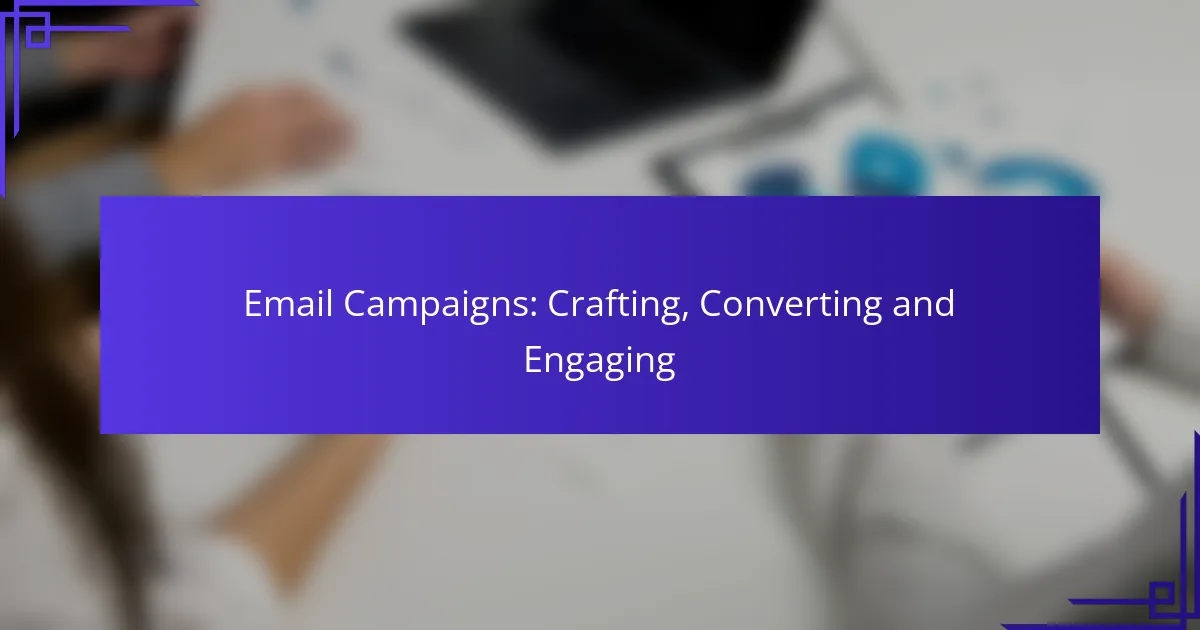Email campaigns are a powerful tool for engaging your audience and driving conversions. By understanding your target market and crafting personalized, compelling content, you can enhance engagement and optimize performance. Implementing best practices and utilizing the right tools can further streamline your efforts and improve your campaign outcomes.
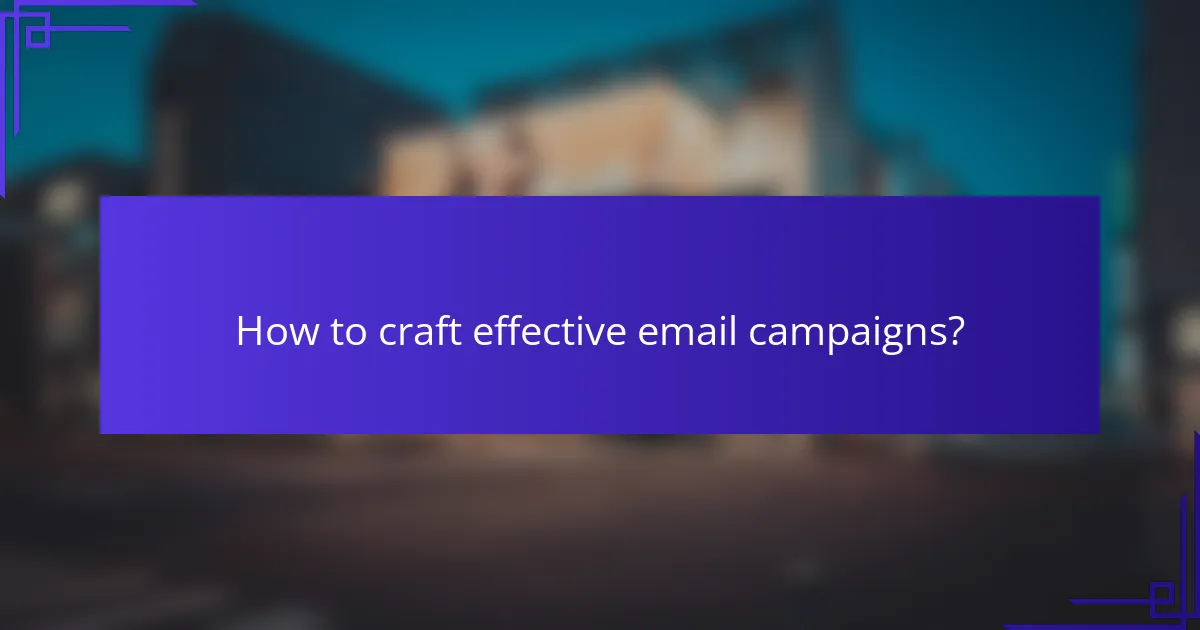
How to craft effective email campaigns?
Crafting effective email campaigns involves understanding your audience, creating engaging content, and optimizing for performance. Key elements include defining your target audience, writing compelling subject lines, and personalizing messages to enhance engagement.
Define target audience
Identifying your target audience is crucial for tailoring your email campaigns. Consider demographics such as age, gender, location, and interests to create segments that resonate with specific groups. This targeted approach increases the likelihood of engagement and conversion.
Utilize tools like surveys or customer data analysis to gather insights about your audience. This information helps in crafting messages that speak directly to their needs and preferences, ultimately improving campaign effectiveness.
Create compelling subject lines
Subject lines are the first impression of your email and play a significant role in open rates. Aim for clarity and intrigue, using action-oriented language to encourage recipients to click. Keep them concise, ideally under 50 characters, to ensure they display well on all devices.
Incorporate personalization, such as the recipient’s name or location, to make the subject line more relevant. Avoid spammy words and excessive punctuation, as these can trigger spam filters and reduce deliverability.
Utilize A/B testing
A/B testing allows you to compare different versions of your emails to determine which performs better. Test elements like subject lines, content layout, and call-to-action buttons to gather data on what resonates with your audience. This iterative process helps refine your strategy over time.
When conducting A/B tests, ensure you have a clear hypothesis and a significant sample size to draw meaningful conclusions. Analyze results based on key metrics such as open rates, click-through rates, and conversions to inform future campaigns.
Design mobile-friendly templates
With a significant portion of emails opened on mobile devices, designing mobile-friendly templates is essential. Use responsive design techniques to ensure your emails look good on various screen sizes. This includes using larger fonts, single-column layouts, and touch-friendly buttons.
Test your emails on multiple devices before sending to ensure compatibility. A well-designed mobile experience enhances user engagement and reduces the likelihood of recipients unsubscribing due to poor readability.
Personalize content for engagement
Personalization goes beyond using the recipient’s name; it involves tailoring content based on their behavior and preferences. Use data from past interactions to send relevant offers, recommendations, or content that aligns with their interests.
Consider implementing dynamic content blocks that change based on user data, such as location or purchase history. This level of personalization can significantly boost engagement rates and foster a stronger connection with your audience.
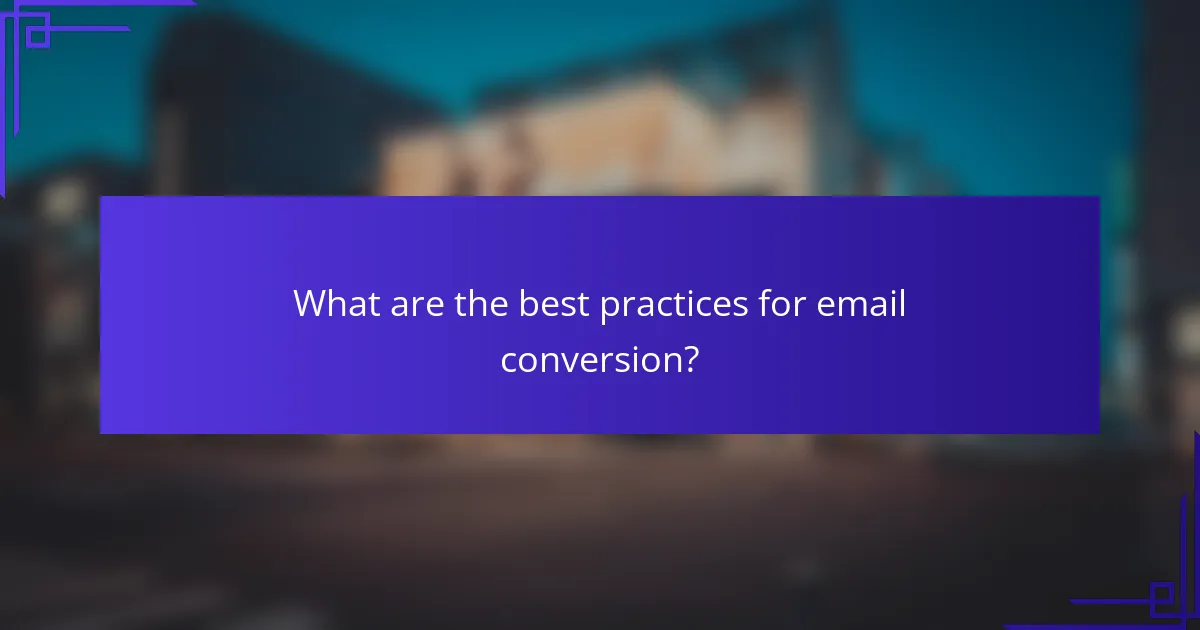
What are the best practices for email conversion?
The best practices for email conversion focus on enhancing user engagement and driving action. By optimizing call-to-action placement, segmenting email lists, using clear messaging, and incorporating social proof, you can significantly improve conversion rates.
Optimize call-to-action placement
Effective call-to-action (CTA) placement is crucial for guiding recipients toward desired actions. Position CTAs above the fold, where they are easily visible, and consider using contrasting colors to make them stand out. Aim for a single, clear CTA per email to avoid overwhelming readers.
Test different placements within your emails, such as at the beginning, middle, or end, to see which location yields the highest click-through rates. A/B testing can provide insights into what works best for your audience.
Segment email lists for relevance
Segmenting your email lists allows you to tailor messages to specific groups based on demographics, behavior, or preferences. This relevance increases the likelihood of engagement and conversion. For instance, sending targeted promotions to frequent buyers can yield better results than a generic offer.
Consider using criteria such as purchase history, location, or engagement level to create segments. Regularly update your segments to reflect changes in subscriber behavior and preferences.
Use clear and concise messaging
Clear and concise messaging is essential for maintaining reader interest and driving conversions. Use straightforward language and get to the point quickly, ensuring that your main message is easily understood. Aim for a reading level that matches your audience’s comprehension.
Utilize bullet points or short paragraphs to break up text and highlight key information. This format makes it easier for readers to scan your email and grasp the essential points quickly.
Incorporate social proof
Social proof, such as testimonials, reviews, or user-generated content, can significantly enhance credibility and encourage conversions. Including positive feedback from satisfied customers can reassure potential buyers about the value of your offer.
Consider showcasing a few select testimonials prominently within your email or linking to a dedicated review page. This strategy can help build trust and influence purchasing decisions, particularly for new or less-known brands.

What tools can enhance email campaigns?
Several tools can significantly improve the effectiveness of email campaigns by streamlining processes, enhancing engagement, and providing valuable insights. Utilizing the right software can help automate tasks, integrate customer relationship management (CRM) systems, and analyze campaign performance.
Mailchimp for automation
Mailchimp is a popular choice for automating email campaigns, allowing users to set up workflows that send targeted messages based on user behavior. This can include welcome emails, follow-ups, and re-engagement campaigns, which help maintain customer interest without manual effort.
To get started with Mailchimp automation, create a series of emails that trigger based on specific actions, such as signing up for a newsletter or abandoning a cart. This approach can increase conversion rates by ensuring timely communication with potential customers.
HubSpot for CRM integration
HubSpot offers robust CRM integration that enhances email campaigns by providing detailed insights into customer interactions and preferences. This integration allows marketers to segment their audience effectively, ensuring that emails are personalized and relevant to each recipient.
When using HubSpot, take advantage of its contact management features to track customer behavior and tailor your email content accordingly. This can lead to higher engagement rates, as recipients receive messages that resonate with their interests and needs.
Constant Contact for analytics
Constant Contact provides comprehensive analytics tools that help marketers measure the performance of their email campaigns. By analyzing open rates, click-through rates, and conversion metrics, users can identify what works and what needs improvement.
To maximize the benefits of Constant Contact’s analytics, regularly review your campaign performance and adjust your strategies based on the data. This iterative process can lead to more effective campaigns and better overall results.
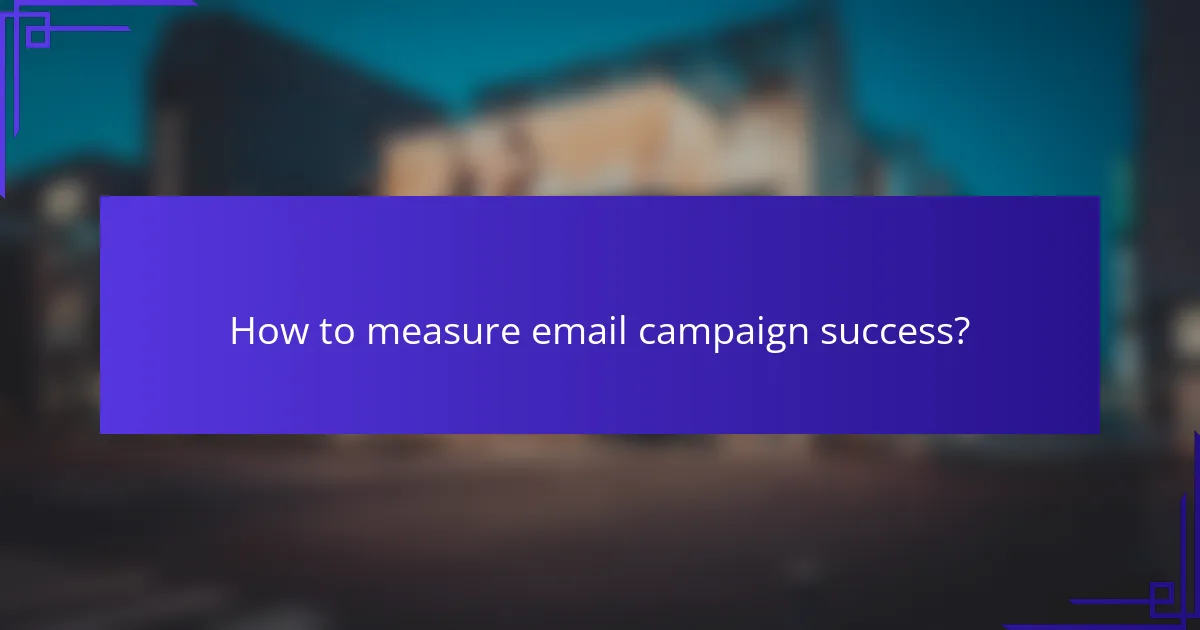
How to measure email campaign success?
Measuring email campaign success involves analyzing key performance indicators (KPIs) that reflect how well your emails are engaging recipients. Focus on metrics such as open rates, click-through rates, and conversion rates to gauge effectiveness and identify areas for improvement.
Track open rates
Open rates indicate the percentage of recipients who opened your email, providing insight into the effectiveness of your subject lines and sender reputation. A good open rate typically ranges from 15% to 25%, but this can vary by industry.
To track open rates, use tracking pixels embedded in your emails. Ensure your email service provider (ESP) supports this feature. Avoid common pitfalls like misleading subject lines, which can lead to higher unsubscribe rates.
Analyze click-through rates
Click-through rates (CTR) measure the percentage of recipients who clicked on links within your email. This metric is crucial for understanding engagement and the effectiveness of your content and calls to action. A typical CTR can range from 2% to 5% depending on the industry.
To improve CTR, ensure your email content is relevant and includes clear, compelling calls to action. A/B testing different link placements and wording can help identify what resonates best with your audience.
Monitor conversion rates
Conversion rates reflect the percentage of recipients who completed a desired action, such as making a purchase or signing up for a newsletter, after clicking through your email. This metric is vital for assessing the overall success of your campaign. Conversion rates can vary widely, often falling between 1% and 5%.
To effectively monitor conversion rates, set up tracking through your website or landing pages. Use tools like Google Analytics to attribute conversions back to specific email campaigns. Focus on optimizing landing pages to ensure they align with the email content and provide a seamless user experience.
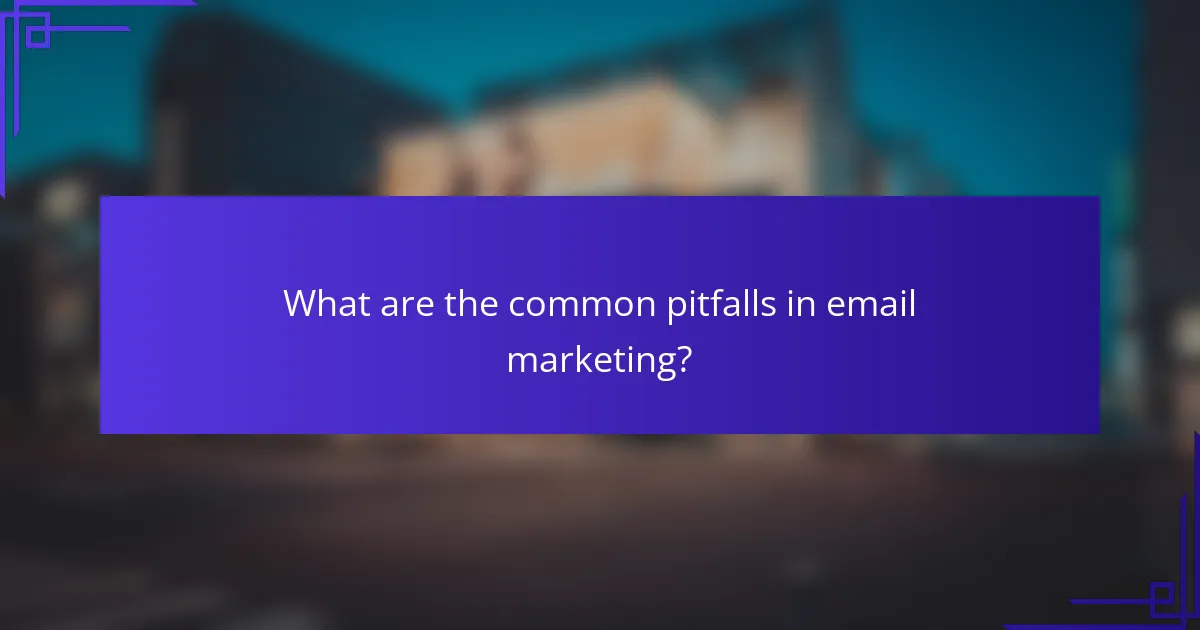
What are the common pitfalls in email marketing?
Common pitfalls in email marketing can significantly hinder campaign effectiveness. Key issues include neglecting mobile optimization, failing to maintain a clean email list, and not adhering to regulations.
Ignoring mobile optimization
Ignoring mobile optimization can lead to a poor user experience, as many recipients read emails on their smartphones. Emails that are not mobile-friendly may appear distorted or difficult to navigate, resulting in lower engagement rates.
To ensure mobile optimization, use responsive design techniques that adjust the layout based on the device’s screen size. Keep subject lines concise and prioritize essential information at the top of the email.
Overlooking list hygiene
Overlooking list hygiene can result in high bounce rates and decreased deliverability. Regularly cleaning your email list by removing inactive subscribers and correcting invalid addresses is crucial for maintaining a healthy list.
Consider implementing a double opt-in process to ensure that subscribers genuinely want to receive your emails. Additionally, periodically review engagement metrics to identify and remove users who have not interacted with your emails over a specified period.
Failing to comply with regulations
Failing to comply with regulations, such as the General Data Protection Regulation (GDPR) in Europe or the CAN-SPAM Act in the United States, can lead to legal penalties and damage to your brand’s reputation. Understanding these regulations is essential for maintaining trust with your audience.
To comply, always obtain explicit consent from subscribers before sending marketing emails and provide clear options for opting out. Include your business address and a straightforward unsubscribe link in every email to adhere to legal requirements.
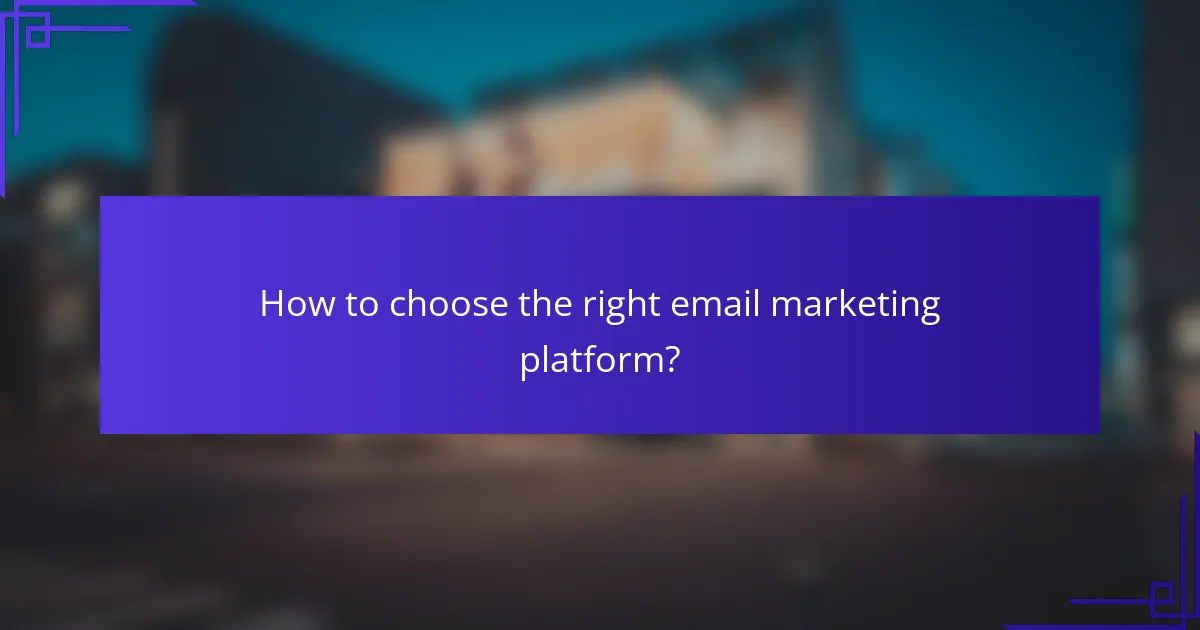
How to choose the right email marketing platform?
Choosing the right email marketing platform involves evaluating features that align with your business goals, budget, and audience needs. Key considerations include ease of use, integration capabilities, and customer support options.
Consider your business size and goals
Your business size and specific marketing goals significantly influence the choice of an email marketing platform. Small businesses may benefit from user-friendly tools with essential features, while larger enterprises might require advanced analytics and automation capabilities.
Identify whether your primary goal is to increase sales, build brand awareness, or engage with customers. This clarity will help you select a platform that offers the right tools and functionalities to meet those objectives.
Evaluate features and integrations
Look for platforms that provide essential features such as customizable templates, automation workflows, and robust analytics. Additionally, consider how well the platform integrates with your existing systems like CRM software or e-commerce platforms.
For example, platforms like Mailchimp and HubSpot offer extensive integrations, making them suitable for businesses looking to streamline their marketing efforts across various channels.
Assess pricing and scalability
Pricing structures vary widely among email marketing platforms, often based on the number of subscribers or emails sent. Start with a budget and compare plans to find one that offers the best value for your needs.
Consider scalability as your business grows. Some platforms offer tiered pricing that allows you to upgrade as your subscriber list expands, ensuring you won’t outgrow your chosen solution too quickly.
Check customer support and resources
Reliable customer support is crucial, especially if you encounter technical issues or need assistance with campaign strategies. Look for platforms that provide multiple support channels, such as live chat, email, and phone support.
Additionally, consider the availability of educational resources like tutorials, webinars, and community forums. These can be invaluable for maximizing the effectiveness of your email marketing campaigns.
